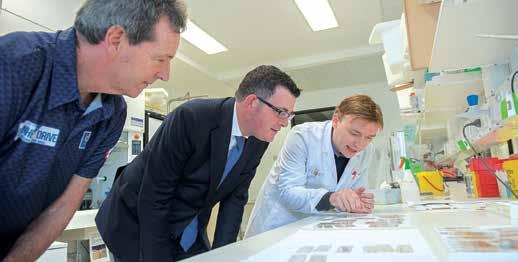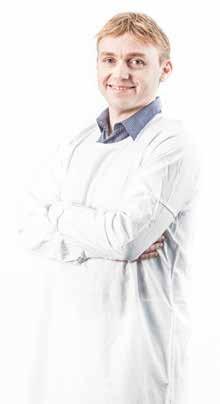
2 minute read
A CURE THE STATS
With a little help from our friends
The success of the Florey’s motor neurone disease (MND) research has attracted generous supporters including Shane Watson, Dr Ian Davis and former Melbourne Football Club champion, Neale Daniher.
Neale, Shane and Ian are making great strides in raising public awareness – and donations – to aid our search for a cure.
Neale’s advocacy has taken public awareness about motor neurone disease to new heights –through the ‘Big Freeze at the G’ in June and a world record achievement at Etihad Stadium for the most people simultaneously taking the ‘ice bucket challenge’.
Neale says, “Every dollar raised will be used to continue the fight against ‘the beast’ by backing the work of researchers like the ones at the Florey Institute.”
It is a brutal disease. Patients initially experience weakness in their hands or feet as nerve cells begin to die. The motor neurones controlling muscles deteriorate throughout the body until the patient can no longer swallow and finally, breathe.
The Florey’s novel, international, collaborative research effort is headed by Dr Brad Turner, who leads a team of enthusiastic and dedicated research scientists, clinicians and PhD students.

Recent results emerging from the lab bench are extremely encouraging.
By adding a protein, SMN, that nourishes motor neurones back into a mouse model of MND, Brad’s team has been able to prolong the lifespan of these mice by over 10 per cent. This finding is being replicated in another MND mouse model to ensure the results are robust.
Other exciting developments in the pipeline include using an immune system modulator to treat MND mice, and eventually delivering therapeutic proteins to damaged motor neurones by using genetically engineered antibodies –the body’s own chemical delivery system.
Brad’s team seeks to combine gene and neurotrophic therapies to improve motor neurone health and connections to muscle in preclinical MND models. Importantly, these therapeutic agents can be rapidly adapted to human studies, accelerating clinical development.
As well researching the molecular events that might lead to MND, the Florey is conducting a number of clinical trials in MND. This work is being performed by Neuroscience Trials
Motor neurone disease
1900 Australians live with MND
More than 800 people are diagnosed with MND in Australia every year, meaning:
Australia, the Florey’s clinical trials platform and led by Dr Tina Soulis.
“We are currently running three separate MND trials which will recruit over 100 participants,” Tina says.
“One of the most exciting trials will aim to determine whether the antiretroviral combination therapy, used to combat HIV, might be useful in reducing the debilitating symptoms of MND and delaying disease progression, while another looks at whether altering copper levels in the cells might have a beneficial effect.”
Great strides have been made with genetic and environmental advances continually emerging. The Florey recognises and thanks those who are helping Brad’s lab in their quest for a cure.
20
Two people are diagnosed every day
Florey researchers have also garnered a total of $3.5M in MND funding from philanthropic sources, including:
$250,000 Cure for MND Collaboration grant from the Motor Neurone Disease Research Institute Australia
There is no cure
$150,000 Shane Watson Grant via Cure for MND Foundation
MND-associated
genes have been discovered in the previous 20 years, with 13 of those identified in the last five.
Just $2.5M of the $420M
2015 NHMRC project grant budget was allocated to MND research.
$3 million from the Stafford Fox Medical Research Foundation
The Florey currently has 12 dedicated researchers working solely on MND









